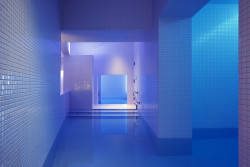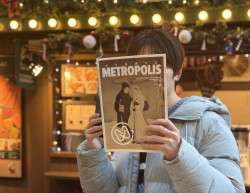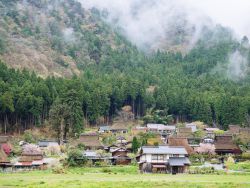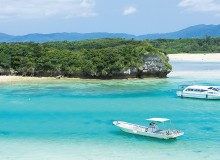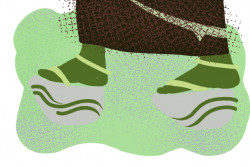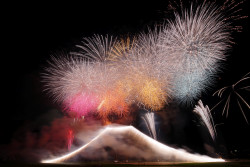
Originally published on metropolis.co.jp on January 2011

Photos by Kimi Jackson
Dismayed by the hordes of hikers we’d encountered on the trails around Tokyo, we sought solace on the Miura Coast, known for little besides its volcanic rocks, agriculture and fishing. On the Miura Gansho no Michi, or Miura Reef Route, just 90 minutes from Shinagawa, there were no package tours or leaders with flags. In fact, we didn’t see any other hikers at all—just a few fishermen, picnicking families and sea creatures dwelling in the ever-changing tide pools.
The Miura Peninsula separates Tokyo Bay from Sagami Bay to the west, with the area known as the Miura Coast lying at its tip, south of Yokohama and Yokosuka. Limited promotion might explain why it isn’t overrun with Tokyoites, and we couldn’t find any English maps, though the route was fairly self-explanatory.
 From Bishamonten Iriguchi bus stop, a speck on a narrow road surrounded by white radish fields, we doubled back and took the second path on the right, at a junction with two stone pillars and a brown pole with green arrows that mark the route. We kept right at the next marker, following the road down a hill, past a temple dedicated to the Buddhist deity Bishamon.
From Bishamonten Iriguchi bus stop, a speck on a narrow road surrounded by white radish fields, we doubled back and took the second path on the right, at a junction with two stone pillars and a brown pole with green arrows that mark the route. We kept right at the next marker, following the road down a hill, past a temple dedicated to the Buddhist deity Bishamon.
On reaching the ocean, we headed right along the sometimes rocky, sometimes sandy coastline. Though there was no trail, it was easy going in most places, and stepping posts were provided when things got rough—a welcome gesture when you’re traversing the route at high tide. When we stopped on the rocks for a picnic lunch, we were nearly joined by two of the many stray cats that inhabit the area, but lost out in their affections to a local man armed with a rucksack of fresh fish.
The Miura Coast has been inhabited for at least two millennia. Along the route is a cave that was first occupied as a dwelling during the Yayoi period (300BC-300AD), and later used as a grave in the Heian era (794-1185). Archeologists have found ornamental, fishing and agricultural artifacts there, but also deer bones, which ancient seers burned to divine the future. The Tsurugizaki Lighthouse, further to the east, is a more recent addition. The current structure was built in 1925, after its Meiji-era predecessor was destroyed in the Great Kanto Earthquake two years earlier.
 Continuing along the coastline past Bishamon, a small fishing cove, we were soon scrambling over multicolored volcanic rocks that looked like they’d flowed out of a melting ice cream factory. Local families were fishing and picnicking in the area, and we followed the example of the children and went searching for crabs, sea anemones and sea slugs in the tide pools. There was also a series of circular depressions in the stone surface, which a local woman told us were remnants of an ancient salt-making operation.
Continuing along the coastline past Bishamon, a small fishing cove, we were soon scrambling over multicolored volcanic rocks that looked like they’d flowed out of a melting ice cream factory. Local families were fishing and picnicking in the area, and we followed the example of the children and went searching for crabs, sea anemones and sea slugs in the tide pools. There was also a series of circular depressions in the stone surface, which a local woman told us were remnants of an ancient salt-making operation.
Hugging the shore on the way past Miyakawa, a small harbor, we arrived at a toilet and vending machine, the only facilities along the hike. A little further along the shore, a road to the right led away from the coast, passing under a high bridge on its way up the hill. Turning left at the crossroad at the top of the slope, we arrived at our destination, Miyakawa-cho bus stop, with just enough time to buy a chu-hi at the convenience store before heading back to Miura Kaigan for a seafood dinner.
Trip Tips
 Take the Keikyu line rapid train from Shinagawa to Miura Kaigan station (1 hour), then hop on the No. 35 bus to Bishamonten Iriguchi (30 min). From the end point at the Miyakawa-cho stop, either take the bus onward to Misaki Higashi Oka, where you can catch another one to Misakiguchi station, or head back to your starting point at Miura Kaigan. Buses are irregular, and it’s worth checking the schedule (Japanese only) at http://meturl.com/keikyu before you set out. From Shinagawa, the combined train and bus fare comes to approximately ¥2,600 roundtrip. Wear sturdy shoes and bring food and water, as there is nowhere to buy supplies until the end of the hike.
Take the Keikyu line rapid train from Shinagawa to Miura Kaigan station (1 hour), then hop on the No. 35 bus to Bishamonten Iriguchi (30 min). From the end point at the Miyakawa-cho stop, either take the bus onward to Misaki Higashi Oka, where you can catch another one to Misakiguchi station, or head back to your starting point at Miura Kaigan. Buses are irregular, and it’s worth checking the schedule (Japanese only) at http://meturl.com/keikyu before you set out. From Shinagawa, the combined train and bus fare comes to approximately ¥2,600 roundtrip. Wear sturdy shoes and bring food and water, as there is nowhere to buy supplies until the end of the hike.
